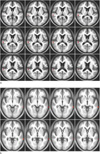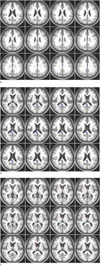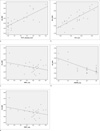Abstract
Purpose
Materials and Methods
Results
Figures and Tables
 | Fig. 1Results of the voxel-based positive correlations between gray matter volume and Rey complex figure test (RCFT) delayed recall scores in Alzheimer's disease (AD) patients (a) or Seoul verbal learning test (SVLT) scores in mild cognitive impairment (MCI) patients (b). |
 | Fig. 2Results of the voxel-based correlations between gray matter volume and Seoul Neuropsychological Screening Battery (SNSB) scores in the elderly cognitive normal (CN) subjects.
a. The negative correlation (blue color) between gray matter volume and Korean version of Boston naming test (K-BNT) scores.
b. The negative correlation (blue color) between gray matter volume and Korean version of mini-mental state examination (K-MMSE) scores
c. The positive correlation (red color) between gray matter volume and Rey complex figure test (RCFT) scores
|
 | Fig. 3Results of the region-of-interest-based correlations between gray matter volume and Seoul Neuropsychological Screening Battery (SNSB) scores.
a. The positive correlation with the Rey complex figure test (RCFT) delayed recall scores in Alzheimer's disease (AD) patients.
b. The positive correlation with the Seoul verbal learning test (SVLT) scores in mild cognitive impairment (MCI) patients.
c. The negative correlation with the Korean version of Boston naming test (K-BNT) scores in the elderly cognitive normal (CN) subjects.
d. The negative correlation with the Korean version of mini-mental state examination (K-MMSE) scores in CN. subjects
e. The positive correlation with the RCFT scores in CN subjects.
|
Table 1

Note.- CN, Cognitive normal; MCI, Mild cognitive impairment; AD, Alzheimer's disease; K-MMSE, Korean version of mini-mental state examination; K-BNT, Korean version of Boston naming test; SVLT, Seoul verbal learning test; RCFT, Rey complex figure test COWAT, Controlled oral word association test; CDR, Clinical dementia rating; Data are listed as the mean ± standard deviation (SD).
Age and gender were statistically significant between MCI and AD or CN and AD (p < 0.05); K-MMSE, Digit Span Forward, K-BNT, RCFT copy, RCFT recognition, COWAT animal, COWAT supermarket were statistically significant between MCI and AD or CN and AD (p < 0.05); *All indices were statistically significant difference among the three groups (p < 0.05).
Table 2

Note.- Rt, right; Lt, left; BA, Brodmann area; Z-score, Z-score of local maxima; ROI, region-of-interest; RCFT, Rey complex figure test; SVLT, Seoul verbal learning test; AD positive correlation: positively significant correlations of brain gray matter volume with the Rey complex figure test (RCFT) delayed recall scores in the Altzheimer's disease (AD) group.; There was no negatively significant correlation with the RCFT delayed recall scores in AD.
MCI positive correlation: positively significant correlations of brain gray matter volume with the Seoul verbal learning test (SVLT) scores in the mild cognitive impairment (MCI) group.
There was no negatively significant correlation with the SVLT scores in MCI.
Table 3

Note.- Rt, right; Lt, left; BA, Brodmann area; Z-score, Z-score of local maxima; ROI, region-of-interest; K-BNT, Korean version of Boston naming test; K-MMSE, Korean version of mini-mental state examination; RCFT, Rey complex figure test; SVLT, Seoul verbal learning test; There were no positively significant correlations with the K-BNT, K-MMSE, RCFT copy, RCFT delayed recall, RCFT, SVLT delayed recall, and SVLT recognition scores.
Table 4

Note.- Pearson, Pearson correlation coefficient; r2, r-square; CDR, Clinical dementia rating; SNSB, Seoul neuropsychological screening battery; STD, Standard deviation; RCFT, Rey complex figure test; SVLT, Seoul verbal learning test; K-BNT, Korean version of Boston naming test; K-MMSE, Korean version of mini-mental state examination
Region-of-interests (ROIs) were listed in Table 2 and 3.
*Gray matter volume (GMV) ranges that show mean±standard deviation (SD) are between 0 (0% gray matter) and 1 (100% gray matter).
SNSB scores of RCFT delayed recall (+), SVLT (+) and RCFT (+) indicate positive correlations with the gray matter volume in brain, respectively.
SNSB scores of K-BNT (-) and K-MMSE (-) indicate negative correlations with the gray matter volume in brain, respectively.




 PDF
PDF ePub
ePub Citation
Citation Print
Print


 XML Download
XML Download